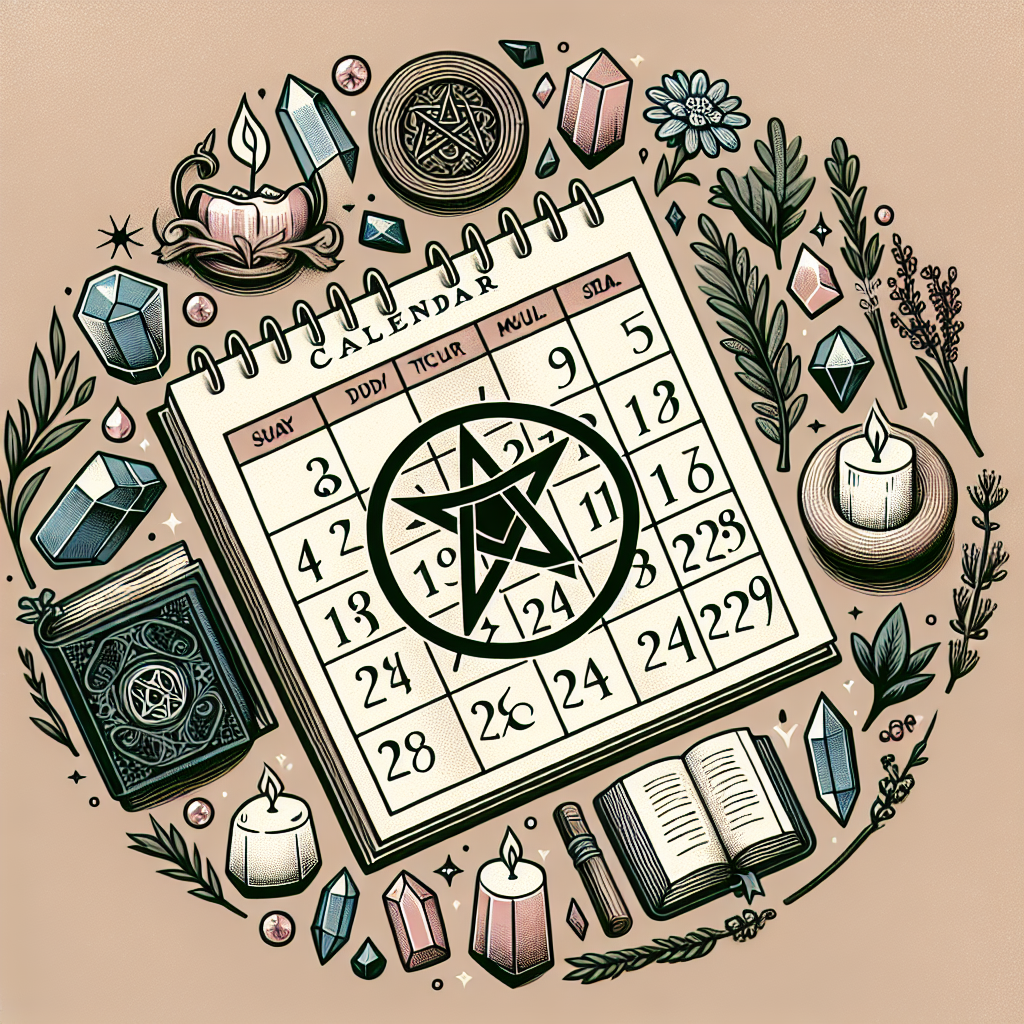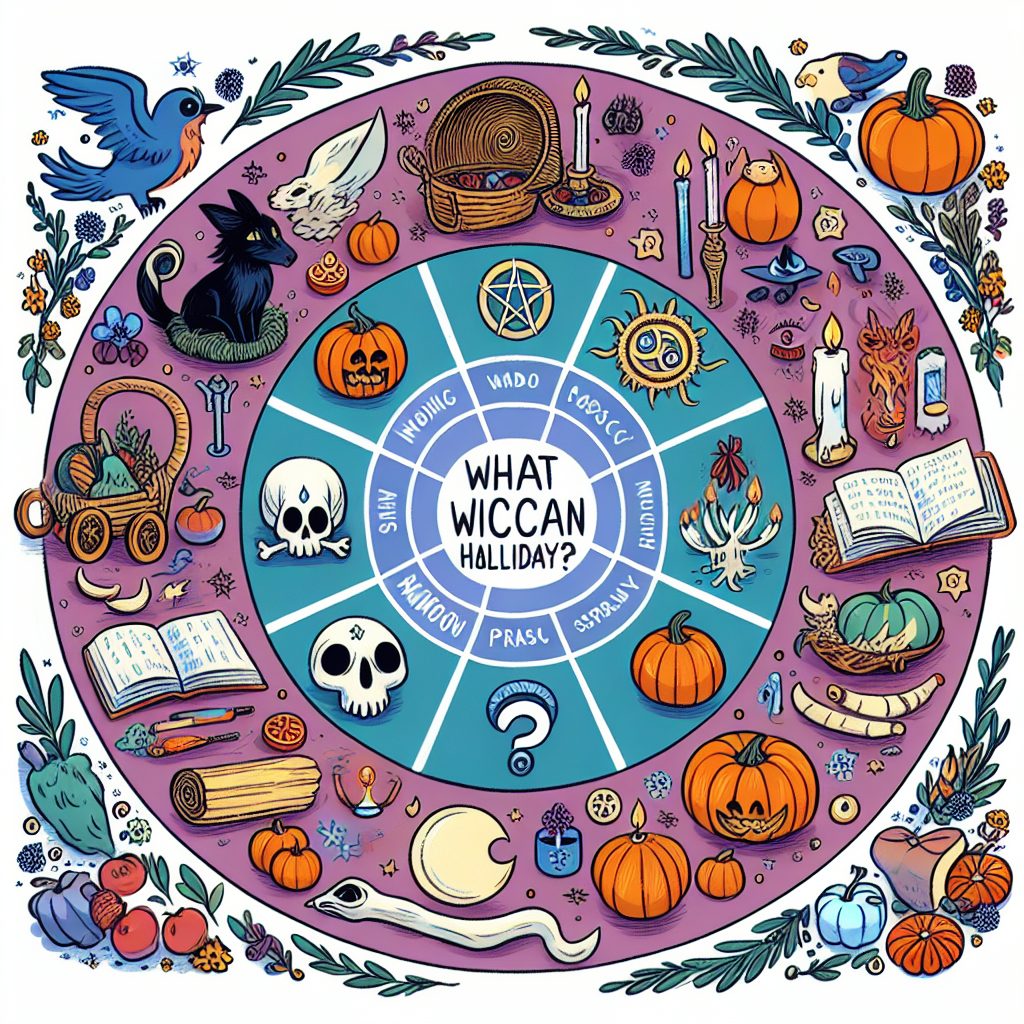As an Amazon Associate I earn from qualifying purchases.

Wicca, a modern pagan religion that celebrates the cycle of the seasons, marks the progression of the year with eight Sabbats, or holidays. These sacred days are deeply intertwined with the Earth’s natural rhythms and are central to the Wiccan belief system. They are split into two types: the four solar festivals, which correspond to the solstices and equinoxes, and the four agricultural or pastoral festivals, which are spaced evenly between them. Together, these Sabbats create the Wheel of the Year, a symbolic calendar used by Wiccans to honor their deities and the spirit of nature.
The roots of these celebrations trace back to ancient pagan festivals which were later woven into the tapestry of Wicca. The religion itself was introduced to the public in the early to mid-20th century by Gerald Gardner, often considered the father of modern Wicca. While the specific customs can vary from one Wiccan group to another, the core principle behind the Sabbats is universal within the faith: they are moments to give thanks, reflect, and engage with the physical and spiritual changes that each season brings. In observing these holidays, Wiccans may participate in rituals, feasting, storytelling, and community gatherings, using these occasions to strengthen their bonds with the divine, nature, and each other.
While the exact dates of the Sabbats can shift from year to year due to the astronomical alignment of the Earth and sun, one thing remains consistent: the cyclical nature of the Wiccan holidays. The Wheel of the Year begins with Samhain, often celebrated on October 31st, and completes its full rotation with the final Sabbat, which precedes Samhain. This vibrant calendar ensures that Wiccans have a holiday to look forward to approximately every six weeks, with each festival offering its unique energies and thematic resonance linked to the time of year in which it falls.
A compelling aspect of the Wiccan Sabbats is that their celebrations often dovetail with secular and other religious holidays, such as Christmas aligning in proximity with Yule or Halloween with Samhain, underscoring the interconnectedness of human festivities across cultures. Wicca, being both inclusive and adaptive, has seen growth in its global following. Studies suggest that modern paganism, including Wicca, has been one of the fastest-growing spiritual groups in the United States and Europe as people seek a more earth-centered spiritual path. Whether drawn by the environmental ethos, the emphasis on gender equality, or the rich tapestry of ritual and mythology, the number of individuals identifying with Wicca has increased significantly since the religion’s more wide-spread inception in the 1950s.
Each Sabbat within the Wheel of the Year plays a crucial role in the spiritual life of Wiccans, fostering a close connection with the cycles of nature. With the approach of each holiday, Wiccans around the world prepare to celebrate in ways that honour tradition while embracing personal interpretation and creativity. Every Sabbat serves as an opportunity not only for celebration but also for personal growth and reflection – to step back from the everyday hustle, connect deeply with the natural world, and realize the ever-turning cycle of life, death, and rebirth that is central to Wiccan philosophy.
`
Explore the Next Wiccan Sabbat: Unveil Upcoming Pagan Festivities
`
As the Wheel of the Year turns, Wiccans and Pagans alike eagerly anticipate the next sacred sabbat, a festival marking the ebb and flow of seasons and celebrating the Earth’s natural rhythms. These sabbats, each with their unique rituals and significance, are cornerstones of Wiccan belief, honoring deities, natural elements, and agricultural cycles. Ranging from the rebirth celebrated during Imbolc to the bountiful harvests of Lammas, these holidays foster a deep connection with the natural world. As each sabbat approaches, practitioners prepare for rituals, feasts, and reflection centered around themes of growth, gratitude, and spiritual renewal. To learn the exact nature and traditions of the upcoming Wiccan holiday, as well as ways to celebrate it, continue reading as we delve into the rich tapestry of Wiccan festivities.
What Wiccan Holiday Is Next? Discover Upcoming Celebrations
Determining what Wiccan holiday is next depends on the current date and the Wheel of the Year, which is the annual cycle of seasonal festivals observed by many modern pagans. The Wheel of the Year consists of eight sabbats: four solar holidays, known as the solstices and equinoxes, and four cross-quarter days that are based on the transitions between the solstices and equinoxes.
As we navigate through the Wheel of the Year, the next holiday approaching will vary. Here, we outline each of the eight Wiccan sabbats to help you discover what Wiccan holiday is next on the calendar.
**Imbolc (February 1)**
Imbolc, also known as Brigid’s Day, is a celebration of the beginning of spring. It falls halfway between the winter solstice (Yule) and the spring equinox (Ostara). If the current date is after Yule and before early February, Imbolc is the next Wiccan holiday.
**Ostara (Spring Equinox, around March 20-23)**
The spring equinox, Ostara, celebrates the balance of day and night and the arrival of longer days. It signifies new beginnings and fertility. If you’re nearing the end of winter, Ostara might be what Wiccan holiday is next.
**Beltane (May 1)**
Beltane is a fire festival that marks the start of the summer. It is a time of fertility, sensuality, and celebration of life. If the current date is after Ostara and before May, look towards Beltane as the next holiday.
**Litha (Summer Solstice, around June 20-23)**
Also known as Midsummer, Litha is the celebration of the longest day of the year and the sun at its peak strength. It’s a holiday of abundance and growth. If Beltane has recently passed, Litha will be the upcoming holiday on the Wheel of the Year.
**Lammas or Lughnasadh (August 1)**
Lammas is the first harvest festival, celebrating the gathering of grain and the fruits of the labour of the previous months. It’s a time of giving thanks and recognizing the fruits of our efforts. As you approach the end of the summer season, Lammas is the festivity to look forward to.
**Mabon (Autumn Equinox, around September 20-23)**
Mabon is the second harvest festival, coinciding with the autumn equinox. As with Ostara, day and night are equal in length, but now, darkness is gaining over the light. It is a time to reflect and give thanks for the abundance of the harvest.
**Samhain (October 31)**
Often acknowledged as the most important of the sabbats, Samhain marks the end of the harvest and the beginning of the darker half of the year. According to tradition, the veil between worlds is at its thinnest, making it an ideal time to honor ancestors and the deceased. If Mabon has already passed, the next Wiccan holiday on the Wheel of the Year would be Samhain.
**Yule (Winter Solstice, around December 20-23)**
Yule or Midwinter celebrates the re-emergence of light as the days start to grow longer again after the longest night of the year. It is a time of hope and rebirth, and a celebration of the sun’s return, and if Samhain has gone by, Yule is next.
As of the latest data, approximately 1.5 million people in the United States identify as Wiccan or Pagan, suggesting that these holidays are becoming an integral part of spiritual practice for a growing number of individuals. It is through these celebrations that the essence of Earth’s cycles and the interconnectivity of life are honored.
“`html
1. How do I find out what the next Wiccan holiday is?
You can look at the Wiccan Wheel of the Year, which shows all eight Sabbats, the festivals that mark the changing seasons and agricultural cycles. The next holiday will be the one that comes next chronologically after the current date.
2. What is the Wheel of the Year?
The Wheel of the Year is a calendar that includes eight festivals or Sabbats that are celebrated by Wiccans and other Pagans. It is structured around the changes in seasons and encompasses both solar events, like solstices and equinoxes, and agricultural festivities.
3. Are Wiccan holidays the same dates every year?
Many Wiccan holidays occur on roughly the same dates every year. However, some of them are based on celestial events, like solstices and equinoxes, and may vary slightly from year to year.
4. Can non-Wiccans celebrate Wiccan holidays?
Yes, non-Wiccans are welcome to celebrate Wiccan holidays if they are interested in honoring nature, the changing seasons, and the holiday’s specific meanings and traditions.
5. How can I celebrate a Wiccan holiday?
Celebrations vary depending on the holiday and the traditions of individual practitioners. Common celebrations include feasting, rituals, crafting, storytelling, and spending time in nature. Researching the specific holiday will provide more focused ideas on how to celebrate it.
6. What is the significance of these holidays to Wiccans?
For Wiccans, these holidays have spiritual significance and are times to honor the divine in nature, celebrate the cycles of the Earth, and reflect on life’s changing phases. They are also opportunities for community, gathering, and ritual.
7. How long do Wiccan holidays last?
The length of observance for Wiccan holidays can vary. Some people celebrate just on the day itself, while others may extend celebrations or rituals over several days.
8. Are there any specific foods associated with Wiccan holidays?
Yes, many Wiccan holidays have traditional foods that are associated with the season or the symbolism of the holiday. For example, Samhain might include apples and pumpkins, while Imbolc is often celebrated with dairy dishes.
9. Is there a difference between Wiccan holidays and Pagan holidays?
Wiccan holidays are a subset of Pagan holidays; not all Pagan paths follow the Wiccan Wheel of the Year, and there can be variations and other holidays in non-Wiccan Pagan traditions.
10. What if I miss celebrating a Wiccan holiday; can I still observe it later?
Yes, flexibility is common in the practice of Wiccan holidays. If you miss the exact date, you can still observe and celebrate the holiday later when you have the time and means to do so meaningfully. It’s the intention and the spirit of the holiday that count the most.
“`
Conclusion
The Wiccan spiritual path honors the changing seasons and cycles of nature through a series of festivals known as Sabbats. The Wheel of the Year, an annual cycle of seasonal festivals, marks these eight significant points in the Wiccan calendar. As each Sabbat approaches, practitioners of Wicca prepare to celebrate with rituals, feasts, and traditions that align with the specific energies and themes of the upcoming holiday. These festivities are not just a means of marking the passage of time; they serve as a way to connect with the Earth’s rhythm, honor the deities and spirits associated with each holiday, and reflect on the lessons and spiritual insights that each season brings.
Understanding the sequence and significance of the Wiccan Sabbats is essential for those who follow or are interested in the Wiccan faith. The article discussed the next holiday in the Wiccan calendar, highlighting how its unique attributes contribute to the overarching tapestry of Wiccan spirituality. Whether it’s a solstice that celebrates the sun’s power or a cross-quarter day marking the transition between seasons, these occasions offer a chance to pause, contemplate, and engage in communal or solitary rituals that foster a deeper connection to the natural world and its cyclical patterns. Keeping track of the Wiccan calendar not only aids in spiritual practice but also enriches the understanding of how ancient customs continue to shape modern celebrations.
Amazon and the Amazon logo are trademarks of Amazon.com, Inc, or its affiliates.


